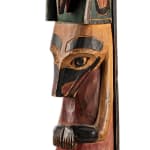-
Artworks
UNIDENTIFIED NUU-CHAH-NULTH ARTIST
Model Totem Pole, c. 1910-20yellow cedar and paint, 18.25 x 3.75 x 4.25 in (46.4 x 9.5 x 10.8 cm)
unsigned;
inscribed in graphite in an unknown hand: "The Hydah / [sic] Indian Totem / Alaska / $12".LOT 25
ESTIMATE: $2,500 — $3,500
PRICE REALIZED: $2,400.00Further images
This model pole was produced by an as-yet-unidentified Nuu-chah-nulth carver who worked for the Ye Olde Curiosity Shop (YOCS) in Seattle, Washington, in the first quarter of the 20th century....This model pole was produced by an as-yet-unidentified Nuu-chah-nulth carver who worked for the Ye Olde Curiosity Shop (YOCS) in Seattle, Washington, in the first quarter of the 20th century. Although we do not currently know the name of this artist, the consistent style and iconography of their poles – along with their preference for distinctively thick wooden bases with live-edges – allows us to identify this as the same maker as the poles illustrated on page 173 of Kate Duncan’s book 1001 Curious Things: Ye Olde Curiosity Shop and Native American Art (2000). In the text, Duncan explains how J.E. Standley, the founder and owner of YOCS, provided model poles by this maker to company Rookwood Pottery to be reproduced as architectural features in the newly built New Washington Hotel in Seattle. [1] Those pottery totem poles remained in the building until 2016, when they were replaced by wooden poles by Tlingit artist Odin Lonning. [2] This pole features, from top, a small bird-like figure, raven, and seated bear with a human face between its legs. The pole is mounted on a dense, burly base with a live edge and is painted in black, red, burgundy, and green pigments.
1. Kate Duncan. 1001 Curious Things: Ye Olde Curiosity Shop and Native American Art. Seattle: University of Washington Press, 171-172.
2. Louis McGill, “Parish’s New Totem Poles Depict Region’s Native, Catholic History,” Northwest Catholic, March 4, 2016,
Christopher W. Smith
Wooden model totem poles were a common type of object offered in souvenir and curio shops in Vancouver, Seattle, and SE Alaska in the late 19th and early 20th centuries. This model was most likely carved by a Nuu-chah-nulth artist, probably between 1900 and 1920. What appears to be a small bird occupies the top position, its wings folded about its body like a cloak. The next figure down represents a raven, its head and long pointed beak turned down upon its body. The wings are folded on each side, and decorated with a single U-form complex to represent feathers. A seated bear is at the bottom, its forelegs tidily poised upon its chest. The bear’s hind legs are drawn up, and between them appears a human face, possibly a reference to the story of the human that married a bear. The pole is attached to a tall square base cut from burly wood. The style and subjects of the carving are in some ways as representative of a more northern origin as one in Nuu-chah-nulth territory on the west coast of Vancouver Island.
Steven C. Brown
Provenance
A Vancouver Collection.
Join our mailing list
* denotes required fields
We will process the personal data you have supplied in accordance with our privacy policy (available on request). You can unsubscribe or change your preferences at any time by clicking the link in our emails.










